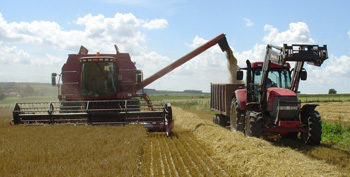Barley harvest begins as values improve

Combines began to roll into the first of the new crop barley this week against a background of improving prices for harvest grain.
Recent rains in Britain and Europe have delayed harvest and stretched remaining old crop supplies, causing feed wheat to peak at £120/t ex-farm in some parts of East Anglia this week. Full-spec Malacca and Hereward wheats briefly touched £140/t in some areas.
Grainfarmers’ David Doyle said the wet weather had caused a “prolonged July” and circumstances had been compounded by April’s long, dry spell. “People were commenting on how far forward wheats were, and anticipating having good quality new crop wheat available earlier than normal. Consequently, some sellers over-committed themselves and buyers failed to cover their positions.”
This had led to sharp improvements in old crop values as traders struggled to fulfil commitments on July and early August positions, he said. “It’s likely this will continue until adequate supplies of new crop wheat are available.”
Feed wheat was worth £105-£108/t off the combine, depending on location, Mr Doyle said, with barley close behind at £100-£105/t as available. “There were some early premium prices available for the veryfirst barley cut up to £110 in somecases, as supplies were so short.”

While Britain was only at the beginning of its harvest campaign, combines in France had cut a considerable amount of barley and some wheat, but the long wet period had hit quality. “I know there have been concerns aboutquality in France and Germany, and particular concerns over Durum wheat in France,” said Mr Doyle.
Futures markets had also strengthened. “Wheat for November movement is worth £113-£116/t ex-farm, which has moved up about £2/t on the week.” Prices of £120/t ex-farm were available for May 2008 and farmers could lock in now to £105/t for November 2009, Mr Doyle said.
Gleadell’s Jonathan Lane said the UK was likely to face a smaller exportable surplus of 1.5-1.6m tonnes. “This should be relatively easy to achieve. Crops in south-east Europe have suffered significantly and we’re not expecting any exports from Romania or the Czech Republic. The Ukraine shows no sign of lifting its export embargo, and Russian wheat is not cheap. The risk in this market is definitely on the upside.”
Jonathan Hoyland, Frontier’s barley and oats manager, said as-available barley was worth £103-£105 in the south of England, while £104-£106/t was achievable further north.
“We expect to have moved about 5000t by the end of the week, mainly south of the M4 with a little bit in East Anglia. We’ve seen one or two malting samples and have been pleasantly surprised with nitrogen results, but it is still very early days.”
*For latest market prices turn to p137
Ian Allen of contractor Allen Bros begins cutting 33 acres of Sequel winter barley on John Perkin’s Nunton House Farm, Maxey, Cambridgeshire, this week. The crop, which came off at 14% moisture, yielded 3t/acre and had been sold forward to merchant Grainfarmers.

